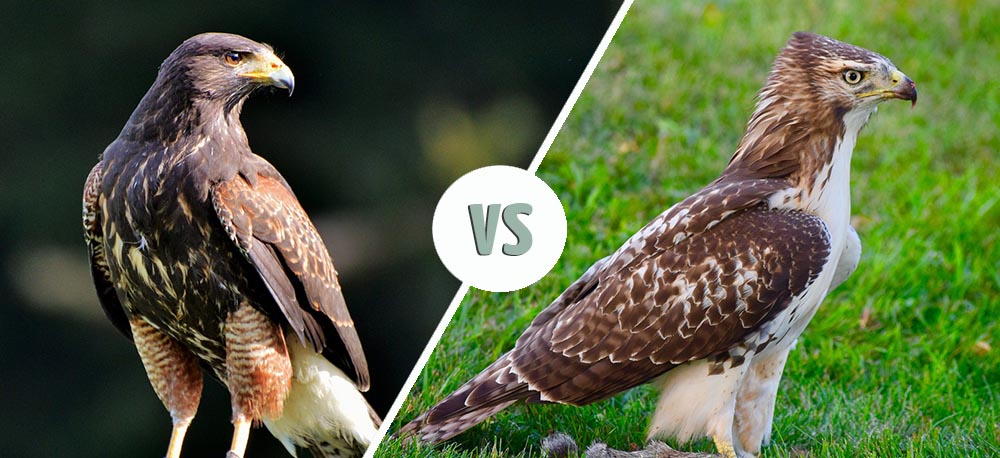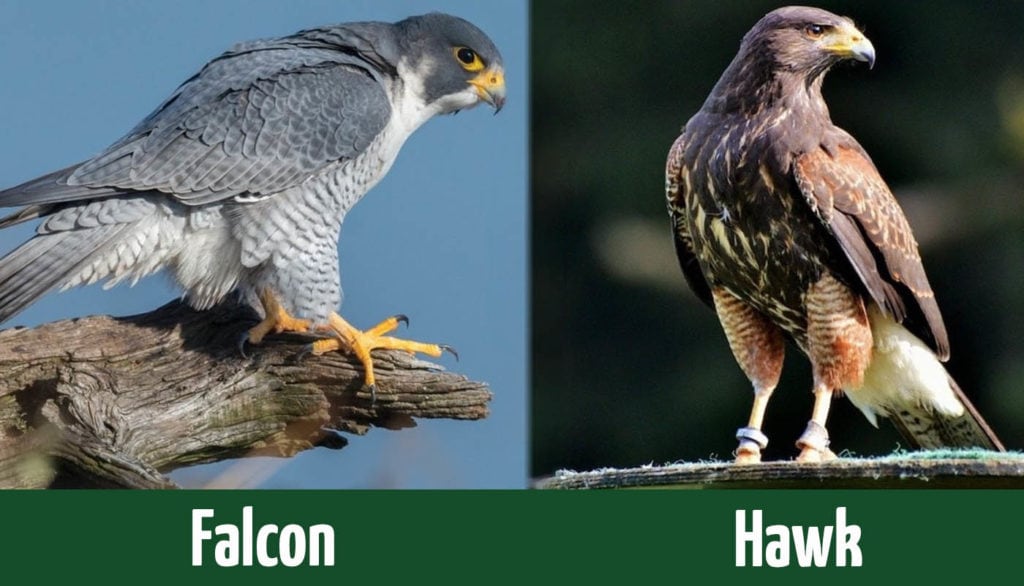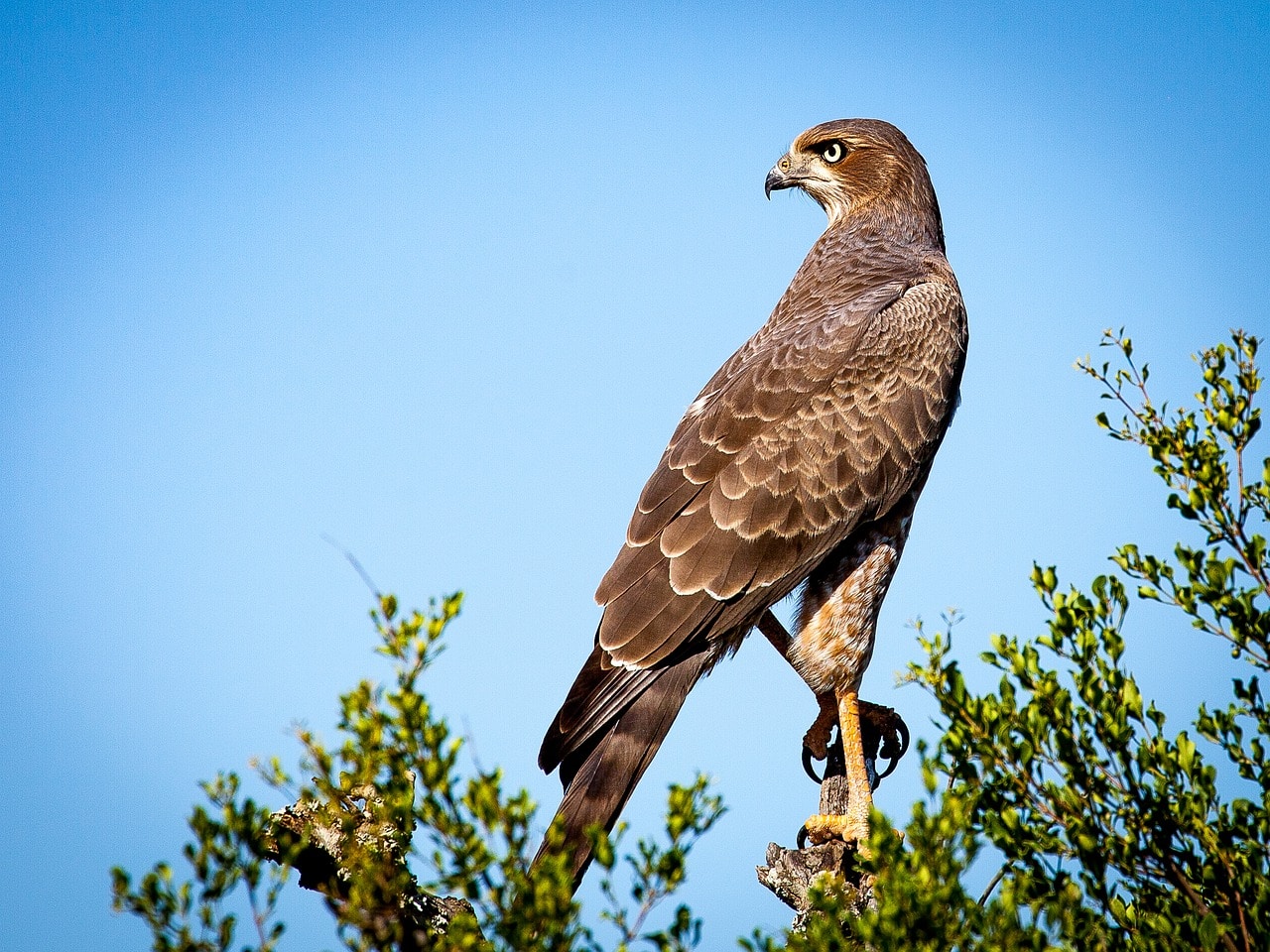Falcon vs. Hawk: The Differences (With Pictures)
Last Updated on

The names of these two types of avians have a lot in common, including being part of the same family, Accipitridae.
They both are birds of prey, although what they hunt often varies. They have similar features, such as a pointy beak and razor-sharp talons. Both kinds have muted coloration patterns that give them an edge with their excellent camouflage.
However, that’s where the similarities end.
The body shapes of the two birds are markedly different, which reflects their hunting behavior. They even fly differently. The relationship that people have with falcons and hawks varies, too. Nevertheless, it’s fair to say that these bird species are both admired and scorned. At the very least, many are misunderstood, despite the critical role they play in ecosystems around the world.
Visual Differences Between Falcons and Hawks

At a Glance: Falcon vs Hawk
- Height Range (adult): 21½–24½ inches
- Weight Range (adult): 1.5–2.6 pounds
- Wingspan: 29–47 inches
- Lifespan: 10–12 years
- Activity Pattern:
- Trainability: Intelligent, loyal, eager to please
- Height Range (adult): 21½–24½ inches
- Weight Range (adult): 2–4 pounds
- Wingspan: 36–56 inches
- Lifespan: 10–12 years
- Activity Pattern:
- Trainability: Intelligent, loyal, eager to please
Falcon Overview

The most distinguishing feature of falcons as a whole is their body shape. They have narrow, pointed wings with long tails that act as a rudder when they fly. These birds can set world records, as evidenced by the fastest verified speed record of 242 mph.
Of course, that gives these birds a significant advantage over their prey. They simply have no time to react to these astonishing speeds. At least, the falcons make it quick, killing the unfortunate ones with their beaks soon after they’ve caught them.
Habitat and Range
You’ll find falcons all over the world to the point that they are even bridging on becoming cosmopolitan. They’ve adapted well to humans and their activities. There are 52 species across the globe. Five occur in the eastern half of the United States, including one accidental bird. The latter are anomalies that typically aren’t found in an area but somehow make their way to unexpected places.
A similar number occurs in the west half of the country, with overlapping ranges.
Falcons live in a broad spectrum of habitats, from grasslands to mountains to forests of all types. You’ll even find them in wetlands and sea coasts. Saying they are adaptable is an understatement.
Behavior
Falcons capitalize on their swift speeds by taking prey in flight after observing them. They can maneuver on a dime to match the changing pattern of the unfortunate victim. They are physically adapted to handle the challenges of this strategy, too. Their eyesight is outstanding, especially since they have to make snap changes while still keeping an eye on their prey.
Most falcons are solitary animals. That’s due in part to their hunting style. There is no evolutionary benefit if they group together. Think of them as the bird version of F14 fighter jets.

Prey Species
There are a lot of similarities of prey species between falcons and hawks. Their environment dictates what they’ll target based on availability. Many species, such as the Peregrine Falcon, feed on a variety of birds, from ducks to hummingbirds. They go after these species because they’re equipped for the job.
However, many falcons are opportunistic. Many things are on the menu, including reptiles, amphibians, rodents, and even bats.
Migration
Many falcons have delineated breeding, non-breeding, and winter ranges. Some species are resident in some areas year-round. It can reflect the species’ physiology and morphology or the availability of prey. These birds usually follow set migration routes, with specific staging areas and winter sites. It’s not unusual for falcons to return to the same locations year after year.
The daylight hours or photoperiod typically act as the trigger for falcons and many birds to migrate. It also signals other life events, such as breeding.
Conservation Status
Many falcon species fall into the category of least species of concern. Having a diverse diet is undoubtedly a point in their favor. That prevents them from becoming vulnerable if a population of a particular prey species declines. Another factor in their favor is the ban on the pesticide DDT. The manufacturer created and synthesized it in the 1940s. It served its purpose to control the insect vectors of malaria.
Unfortunately, the pesticide accumulated in the prey species of many birds of prey. The more animals they consumed, the more it built up in their bodies, leading to premature death. Other species suffered similar fates, particularly those high on the food chain. Today, many falcon species have seen increases in their populations by three figures. Others have at least stabilized.
Relationship With Humans

The relationship with falcons is a double-edged sword. Falconry or hunting with birds of prey goes back to . Some species lend themselves to this pastime more readily than others. The intelligence of these birds is another advantage. It’s a sport that is still enjoyed to this day. That’s the positive side of the coin.
The downside is the hunting behavior of falcons. Many species go after songbird species. They are smart enough to figure out the relationship between bird feeders and likely victims. That fact, albeit its biology, has angered birdwatchers. It all depends on which side of the argument you embrace.
Hawk Overview

Hawks are a more diverse group of birds that include several families with varying specializations. Like falcons, they cover the globe, with the exception of Antarctica. There are 208 species worldwide, with 17 native birds and five accidental ones in the eastern United States. The diversity of the family means that you’ll see birds in specific niches in the Southwest or southern states.
The primary subfamilies in the country are Buteoninae, Accipitrinae, and Elaninae. You’ll see both ends of the spectrum, from niche specialization to generalists. Both are evolutionary-sound strategies that also ensure their viability and adaptability to a changing world.
Habitat and Range
Hawks occupy a similar diversity of habitats and ranges. Many species have adapted to human settings and adapted to their presence. These birds aren’t confined to the wilderness. Many live in suburban settings and do well despite the environmental pressures. Likewise, you’ll find hawks in a variety of habitats, from open country to deep forests.
Hawks often take advantage of the opportunities of these varying habitats. You’ll see specializations that cover the gamut of behavior from body form to hunting strategy.
Behavior
Hawks often use a different playbook of hunting styles than falcons. Speed isn’t usually their forte because of their stockier size and the different shapes of their body features. Many have broader wings and tails that are sometimes rounded. Consequently, some species soar and scour the landscape for prey. Others perch and lie in wait.
Some birds silently glide through the air to take their prey. You’ll see others that hover or take aerial dives to finish the job. On the other hand, there are varying patterns of cooperative hunting. While it’s not the norm, some species such as Harris’s Hawks engage in this behavior.

Prey Species
The prey of hawks and falcons are similar. Habitat is the deciding factor instead of the species. Cooperative hunting often reflects their availability, as with the flushing behavior of the Rough-Legged Hawk with Prairie Dogs. They will take the usual run of birds, reptiles, rodents, and small animals. Their talons are their main weapon to kill their prey.
Many species are opportunistic, which gives them a competitive edge that helps to ensure their long-term survival.
Migration
Most hawk species migrate to a winter staging area. Some are resident in areas with readily available prey and suitable living conditions. These birds also follow set migration routes, wintering in the same places and returning to the same nesting spots. It’s an evolutionarily advantageous strategy that minimizes energy loss.
Like falcons, hawks often migrate in large groups. The competition factor is off the radar during these the times of year. Birdwatchers often report hundreds and thousands of birds during migration.
Conservation Status
Most hawk species are species of least concern because of their adaptability and opportunistic feeding styles. Many are increasing in size, such as the Red-Tailed Hawk. With the removal of the threat of DDT, these birds have stabilized and increased in numbers, reflecting the healthier environments on which they inhabit.
Relationship With Humans
Hawks have a similar relationship with humans, albeit with fewer species. The concerns are similar with songbirds and even pets. It’s not unusual for a larger hawk to take a family pet. It’s just a bird of prey acting on its instincts. The usual pressures of development and habitat degradation also exist. After all, adaptation only takes an organism so far.

Final Thoughts
Falcons and hawks are the kings and queens of the avian world. They rely on different strategies with some similarities to cope with a changing world to survive. A generalist strategy of feeding is a distinct advantage that will ensure we see them soaring in the sky above or darting about for decades to come.
You might also be interested in:
Featured Image Credit: (L) Ralph, Pixabay | (R) sondinh2000, Pixabay
Table of Contents
About the Author Robert Sparks
Robert’s obsession with all things optical started early in life, when his optician father would bring home prototypes for Robert to play with. Nowadays, Robert is dedicated to helping others find the right optics for their needs. His hobbies include astronomy, astrophysics, and model building. Originally from Newark, NJ, he resides in Santa Fe, New Mexico, where the nighttime skies are filled with glittering stars.
Related Articles:
Monocular vs Telescope: Differences Explained (With Pictures)
How to Clean a Refractor Telescope: Step-by-Step Guide
How to Clean a Telescope Eyepiece: Step-by-Step Guide
How to Clean a Rifle Scope: 8 Expert Tips
What Is a Monocular Used For? 8 Common Functions
How to Clean a Telescope Mirror: 8 Expert Tips
Brightfield vs Phase Contrast Microscopy: The Differences Explained
SkyCamHD Drone Review: Pros, Cons, FAQ, & Verdict
